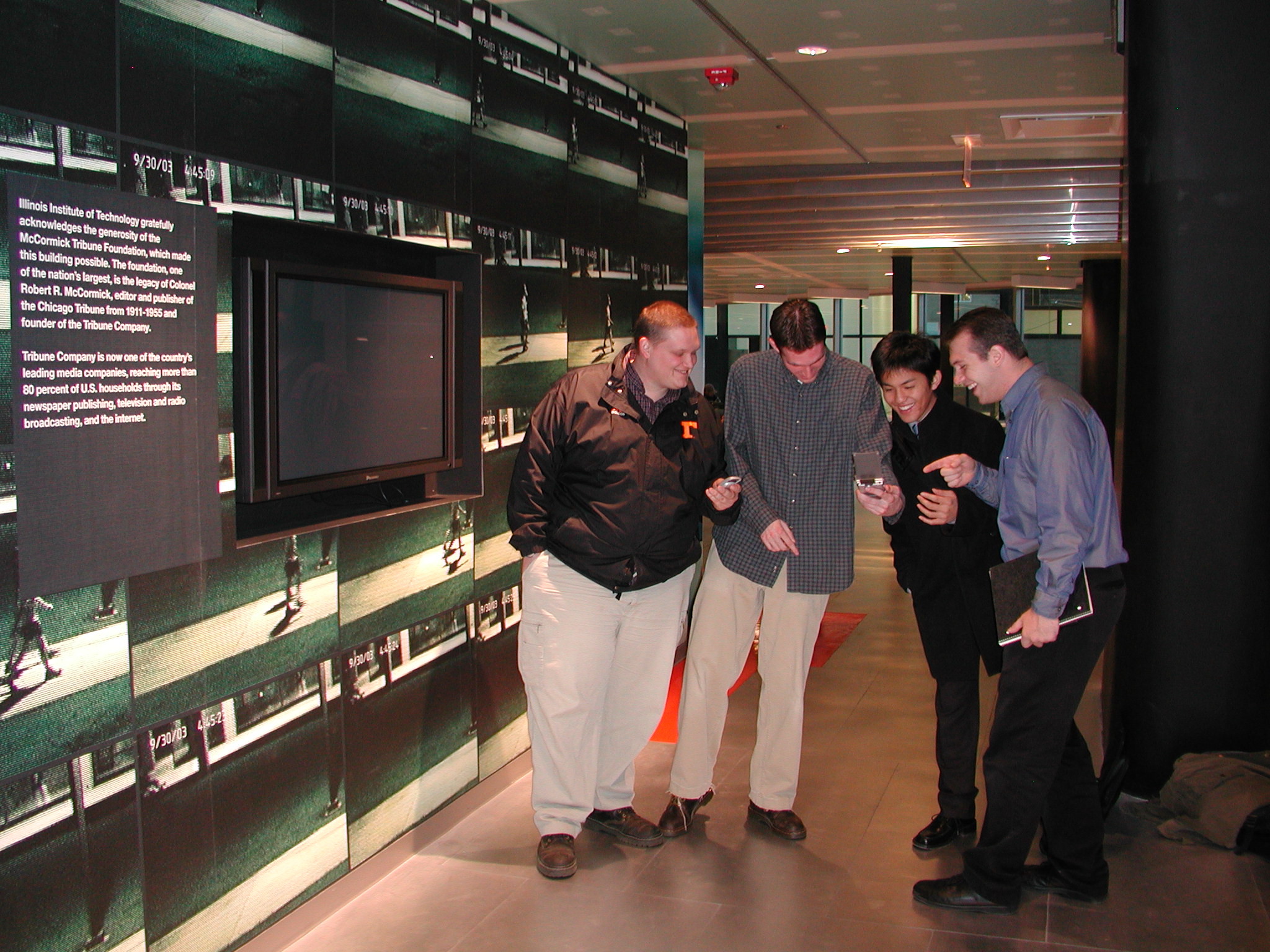
Pervasive Computing
-
An Introductory Article (in Chinese)

|
|
Pervasive Computing
|
|
Computing addresses the issues of making human life easier, but in true sense in today’s computing the users have to follow computing rather then other way around. With the advance of mobile computing and wireless communication technologies, pervasive computing has emerged as a feasible technology for “human-centered” computing. Pervasive Computing creates a ubiquitous environment that combines processors and sensors with network technologies (wireless and otherwise) and intelligent software to create an immerse environment to improve life, in which computers have become an embedded intrinsic part of a sophisticated, networked, pervasive and ubiquitous computing environments around humans.
New challenges
of pervasive computing include mobility (including computing mobility, network
mobility, and user mobility), context aware (smartness), and cross-platform
service. SCS group
has made contribution in all the three areas. We have developed the
“cross network (phone network and
internet) service” mechanism so that internet can share phone system’s
reliability and phone system can share internet’s functionality. Applications
of the crossing-network service include surveillance
(monitor landline phone on computer in addition to monitor cell
phone), disaster relief, and increase user experience.
We have successfully developed a prototype of context-aware supporting system, Scarlet. Scarlet collects context information from smart space and supplies it to smart context aware applications. It can run on different hardware and software systems, can add in new services and new applications easily, and can work well on large or small devices. Applications of Scarlet include identifying location (in the range of 3 feet) inside buildings, and providing anywhere, anytime service. Our success in mobility is based on our contribution on computing mobility, network mobility, and environment adaptation (awareness).
To introduce the new
development in pervasive computing to students outside our research group, we
have developed two new courses in the area. These courses got wide
acceptance from students. They are:
(1) Graduate research course :
'Pervasive computing and Web services'
(2) Undergraduate Inter-Professional Research
Opportunity (IPRO) course: 'IPRO305 Application
of Pervasive Computing'
(1) Context aware computing :
Pervasive
computing ultimate goal is to provide 'Human Centered Computing'. Computer
should understand the context of the human need and provide service
automatically. Context
is useful information other than user input, such as what
the user is doing, where he/she is located, what the surrounding resource, what
is his/her intent in using the resources. For instance, during a soccer game,
the system should help you collaborate with your teammates, and during an exam
it should not. Context
Awareness is the ability to capture, understand and adapt to surrounding
context information.
Context aware system is the system capture context information via ‘embedded’
devices and takes action without explicit user input.
SCS lab’s approach in context-awareness is separating the context applications with context aware infrastructure, where the infrastructure provides common functionalities and application software provides application specific functionalities. Following the basic approach used in the OGSA, a design for Grid computing, we have designed and developed a prototype context-aware infrastructure middleware, Scarlet.
(2) Cross Network Services :
Recent
growth in mobile device usage gave rise to 3G technologies. But the Public
Switched Telephone Network (PSTN) has been weaved in our life since last many
decades. So in
this cellular age, the convergence of PSTN to pervasive computing will be
of great interest. Through the vision of pervasive computing, we tried to integrate old and
existing technology with new technology. In weaving them together, we tried to
capture the environment context and provided better services to user.
One
of the most successful technologies integrated with the daily human life is the
PSTN - a telecommunication infrastructure. PSTN is the oldest way of
communication with people and allows them to stay connected even in the place
where usual cellular phone service does not work. PSTN is weaved in our daily life from many decades and still known for
it’s features like QoS and security of information provided in end to end
communication. Now a day, PSTN is extended to cellular networks too and so it is
possible to provide wireless access to end-user. On the other hand, Internet is
another big distributed network heavily used in daily life for multi media
information exchange. Also growth into IP based solution, contributed to heavy
growth in Internet. In today’s scenario, it is very difficult to imagine life
without Internet.
The hypothesis of this research has developed Instant messaging and Presence notification system by capturing new events generated into PSTN and notify this event information to PDA with IP based network. This information can be presented to in terms of text messages in real time.
(3) Pervasive Applications:
|
HawkTour - A Context Aware Campus Tour : Hawk Tour is a context aware Campus Tour application, a project conducted at Illinois Institute of Technology (IIT) via an Inter-professional (Ipro) team. It provides Campus information on demand. It runs on PDAs, Tablet PCs, and other mobile devices, and the content can be shown on the digital devices or on a display interface near by. IITour is supported, wirelessly, by a campus wide context-aware middleware. Once it is initiated it will be completely driven by user location and intent. Based on the current location and his/her orientation (or the PDA's orientation) of a user, it dynamically retrieves necessary campus information and presents it to user through the user-friendly interface. It shows map of the current location and it’s associated campus information, like near room, nearby restroom, Coffee shop, a historic wall, some historic information about the building etc. The key point is, the information are presented to user based on his current location and action are taken based on it’s intent. |
 |
Following related links are useful for beginner to start research into pervasive computing.
Good place to start :
Publication and Paper database:
Context Aware computing :
Latest wireless technology and Web Services :
Middleware Initiative